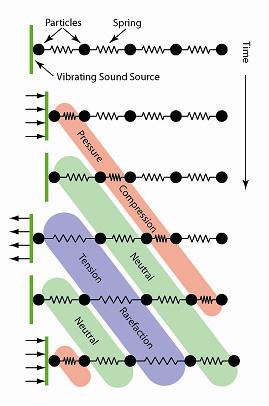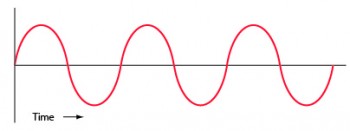I’ve made reference in the blog before to the fact that some surfaces are good candidates for ultrasonic cleaning while others are either difficult or impossible to clean. In general, surfaces that are hard (metal, glass) are easily cleaned using ultrasonics while softer surfaces (rubber, soft plastic) resist ultrasonic cleaning. The reason has to do with the physics of sound (are you surprised?). In this series of several blogs, I will first introduce some basic physics and then expand on this knowledge to suggest ways achieve better ultrasonic cleaning results based on the knowledge of the physics of sound.
To visualize sound waves, we often use a graphic representation similar to the one below.
As a sound wave travels through an elastic media it consists of a traveling series of compressions and rarefactions. It is common to interpret the Y axis in the above diagram to indicate areas of negative and positive pressure. However, the thing responsible for the variations in pressure is the inertia of the media. Where there is pressure, it is because the media is compressed due to the fact that, because it is elastic, the transmission of motion from one molecule or atom to the next is slightly delayed as the inertia of the particle receiving the motion is overcome.
Inertia is the resistance of any physical object to any change in its state of motion, including changes to its speed and direction.
The motion of atoms of molecules of the media, then, is in response to pressure but it is slightly delayed by inertia. As forward motion takes place, pressure is relieved. This may be better understood graphically by studying the following illustration which was published in an earlier blog.

The negative pressure portion of the sound wave is a result of the inertia of motion in the medium in the direction opposite to the direction that the wave is traveling.
When traveling through a boundless media, sound waves will continue to propagate until they finally decay into heat as a result of the internal friction of the sound conducting medium. In liquids, cavitation bubbles will form and implode throughout the liquid as long as there is sufficient energy left in the sound wave. However, this all changes when a sound wave encounters a discontinuity in its path in the form, for example, of a tank wall or a part being ultrasonically cleaned.
When a sound wave encounters a discontinuity there are several possible outcomes – reflection, absorption and/or transmission depending on the physical nature and geometry of the discontinuity.
Note – In the upcoming blogs, I will be using examples chosen to illustrate principles of the physics of sound relevant to ultrasonic cleaning. My apologies to the physicists and physics “purists” out there as I try to bring this complex topic to a level that I can understand and share with the readers of this blog.
– FJF –



 English
English Spanish
Spanish Chinese
Chinese Canada
Canada Mexico
Mexico United Kingdom
United Kingdom




